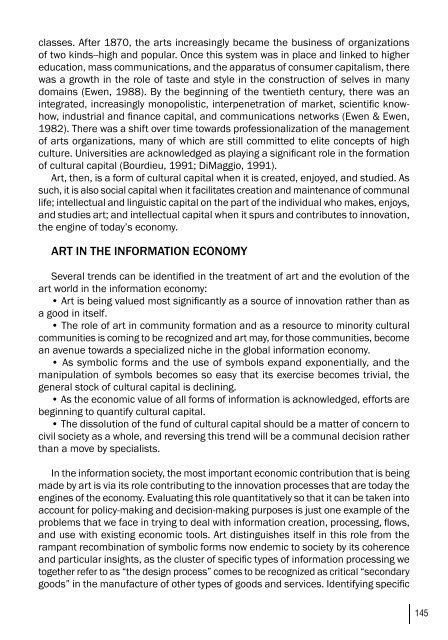art-e-conomy _ reader - marko stamenkovic
art-e-conomy _ reader - marko stamenkovic
art-e-conomy _ reader - marko stamenkovic
You also want an ePaper? Increase the reach of your titles
YUMPU automatically turns print PDFs into web optimized ePapers that Google loves.
classes. After 1870, the <strong>art</strong>s increasingly became the business of organizations<br />
of two kinds--high and popular. Once this system was in place and linked to higher<br />
education, mass communications, and the apparatus of consumer capitalism, there<br />
was a growth in the role of taste and style in the construction of selves in many<br />
domains (Ewen, 1988). By the beginning of the twentieth century, there was an<br />
integrated, increasingly monopolistic, interpenetration of market, scientific knowhow,<br />
industrial and finance capital, and communications networks (Ewen & Ewen,<br />
1982). There was a shift over time towards professionalization of the management<br />
of <strong>art</strong>s organizations, many of which are still committed to elite concepts of high<br />
culture. Universities are acknowledged as playing a significant role in the formation<br />
of cultural capital (Bourdieu, 1991; DiMaggio, 1991).<br />
Art, then, is a form of cultural capital when it is created, enjoyed, and studied. As<br />
such, it is also social capital when it facilitates creation and maintenance of communal<br />
life; intellectual and linguistic capital on the p<strong>art</strong> of the individual who makes, enjoys,<br />
and studies <strong>art</strong>; and intellectual capital when it spurs and contributes to innovation,<br />
the engine of today’s e<strong>conomy</strong>.<br />
ART IN THE INFORMATION ECONOMY<br />
Several trends can be identified in the treatment of <strong>art</strong> and the evolution of the<br />
<strong>art</strong> world in the information e<strong>conomy</strong>:<br />
• Art is being valued most significantly as a source of innovation rather than as<br />
a good in itself.<br />
• The role of <strong>art</strong> in community formation and as a resource to minority cultural<br />
communities is coming to be recognized and <strong>art</strong> may, for those communities, become<br />
an avenue towards a specialized niche in the global information e<strong>conomy</strong>.<br />
• As symbolic forms and the use of symbols expand exponentially, and the<br />
manipulation of symbols becomes so easy that its exercise becomes trivial, the<br />
general stock of cultural capital is declining.<br />
• As the economic value of all forms of information is acknowledged, efforts are<br />
beginning to quantify cultural capital.<br />
• The dissolution of the fund of cultural capital should be a matter of concern to<br />
civil society as a whole, and reversing this trend will be a communal decision rather<br />
than a move by specialists.<br />
In the information society, the most important economic contribution that is being<br />
made by <strong>art</strong> is via its role contributing to the innovation processes that are today the<br />
engines of the e<strong>conomy</strong>. Evaluating this role quantitatively so that it can be taken into<br />
account for policy-making and decision-making purposes is just one example of the<br />
problems that we face in trying to deal with information creation, processing, flows,<br />
and use with existing economic tools. Art distinguishes itself in this role from the<br />
rampant recombination of symbolic forms now endemic to society by its coherence<br />
and p<strong>art</strong>icular insights, as the cluster of specific types of information processing we<br />
together refer to as “the design process” comes to be recognized as critical “secondary<br />
goods” in the manufacture of other types of goods and services. Identifying specific<br />
145


